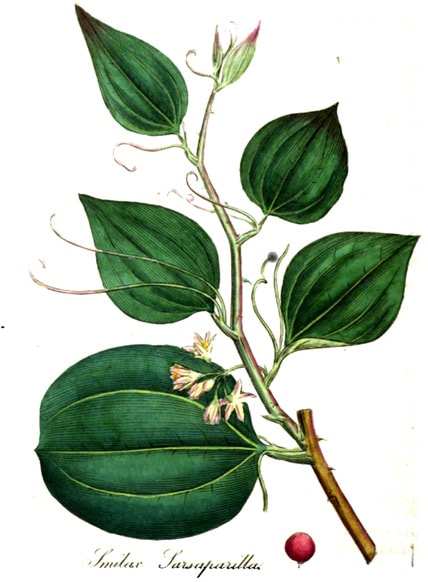Icones Plantarum Medcio-oeconomico, Vietz, 1804
Medical Botany, Woodville, 1810
Botanical name:
Smilax sarsaparilla (syn. S. glauca)
The related Smilax glabra, 'China root' (and others) from China are also used. See China root, Tu Fu Ling
Parts used:
Root
Temperature & Taste:
Neutral. Sweet.
Classifications:
2F. PURIFYING
3A. SUDORIFICS & DIAPHORETICS. 3M. ARTHRITICS
Smilax sarsaparilla (syn. S. glauca)
The related Smilax glabra, 'China root' (and others) from China are also used. See China root, Tu Fu Ling
Parts used:
Root
Temperature & Taste:
Neutral. Sweet.
Classifications:
2F. PURIFYING
3A. SUDORIFICS & DIAPHORETICS. 3M. ARTHRITICS
ADVERTISEMENT:
Uses:
1. Clears Heat, Damp and Toxin, Promotes Urine:
-Joint Pain including Rheumatism and Rheumatoid Arthritis;
-hot, painful Urination, or Jaundice, especially when present with both heat and damp symptoms.
-conditions such as Scrofula, Lymphadenitis, Tumors when presenting with appropriate symptoms.
2. Clears Heat, Damp and Toxin from the Skin:
-recurrent Ulcers, Venereal Disease (especially Syphilis), Thrush, and other skin diseases or lesions from toxic heat, or heat and dampness.
-Internally and externally it is used for such conditions as Eczema and Psoriasis.
3. Strengthens the Kidneys:
-Native American healers have used Sarsaparilla for Impotence and Sexual Debility.
4. Settles Wind:
-It has also been used for Hypertension.
Dose:
Powder: 2–6 grams;
Comment:
Traditionally much used in ‘Diet Drinks’, cleansing drinks taken in the treatment of various chronic conditions. Often combined with Guaiacum, Sassafras and other alteratives, a decoction being taken throughout the day as common drink. Used like this in chronic and obstinate diseases such as joint disease, chronic skin complaints, Fibroid Tumors and Cancer.
Powder: 2–6 grams;
Comment:
Traditionally much used in ‘Diet Drinks’, cleansing drinks taken in the treatment of various chronic conditions. Often combined with Guaiacum, Sassafras and other alteratives, a decoction being taken throughout the day as common drink. Used like this in chronic and obstinate diseases such as joint disease, chronic skin complaints, Fibroid Tumors and Cancer.
Main Combinations:
Guaiacum & Sarsaparilla
1. Rheumatic pains, Ulcers, Skin disease:
i. Sarsaparilla with ... available in PRO version
ii. Sarsaparilla with ... available in PRO version
2. Syphilis, Edema and Arthritic complaints, Sarsaparilla with ... available in PRO version
3. To clear Heat and Toxin from the Blood:
i. Sarsaparilla with ... available in PRO version
ii. Sarsaparilla with ... available in PRO version
4. Skin and Joint diseases:
i. Sarsaparilla with ... available in PRO version
ii. Sarsaparilla ... available in PRO version
iii. Sarsaparilla with ... available in PRO version
5. Scrofula:
i. Sarsaparilla with ... available in PRO version
ii. Sarsaparilla with ... available in PRO version
6. Arthritis:
i. Sarsaparilla with ... available in PRO version
ii. Sarsaparilla with ... available in PRO version
Major Formula:
Decoction of Guaiacum and Sarsaparilla
Decoction of Sarsaparilla Against Apoplexy
Decoction for Skin Disease
Decoction Liberans
Decoction of Woods
Decoction to Sweeten
Sudorific Vinegar
ADVERTISEMENT:
Guaiacum & Sarsaparilla
1. Rheumatic pains, Ulcers, Skin disease:
i. Sarsaparilla with ... available in PRO version
ii. Sarsaparilla with ... available in PRO version
2. Syphilis, Edema and Arthritic complaints, Sarsaparilla with ... available in PRO version
3. To clear Heat and Toxin from the Blood:
i. Sarsaparilla with ... available in PRO version
ii. Sarsaparilla with ... available in PRO version
4. Skin and Joint diseases:
i. Sarsaparilla with ... available in PRO version
ii. Sarsaparilla ... available in PRO version
iii. Sarsaparilla with ... available in PRO version
5. Scrofula:
i. Sarsaparilla with ... available in PRO version
ii. Sarsaparilla with ... available in PRO version
6. Arthritis:
i. Sarsaparilla with ... available in PRO version
ii. Sarsaparilla with ... available in PRO version
Major Formula:
Decoction of Guaiacum and Sarsaparilla
Decoction of Sarsaparilla Against Apoplexy
Decoction for Skin Disease
Decoction Liberans
Decoction of Woods
Decoction to Sweeten
Sudorific Vinegar
ADVERTISEMENT:
Cautions:
Generally Safe and well tolerated.
Main Preparations used:
Generally Safe and well tolerated.
Main Preparations used:
History
|
'Monardes has recorded that sarsaparilla was first introduced to Seville about the year 1536 or 1545, from New Spain; and a better variety soon afterwards from Honduras. He further narrates that a drug of excellent quality was subsequently imported from the province of Quito, that it was collected in the neighbourhood of Guayaquil, and was of a dark hue, and larger and thicker than that of Honduras.
Pedro de Ciezo de Leon, in his Chronicle of Peru, which contains the observations made by him in South America between 1532 and 1550, gives a particular account of the sarsaparilla which grows in the province of Guayaquil and the adjacent island of Puna, and recommends the sudorific treatment of syphilis, exactly as pursued at the present time. These statements are confirmed by the testimony of other writers. Thus, Joao Rodriguez de Castello Branco, commonly known as Amatus Lusitanus, a Portuguese physician of Jewish origin, who practised chiefly in Italy, has left a work recording his medical experiences and narrating cases of successful treatment. One of the latter concerns a patient suffering from acute rheumatism for |
whom he finally prescribed Sarsaparilla. This drug, he explains, has of late years been brought from the newly found country of Peru, that it is in long whip-like roots, growing from the stock of a sort of bramble resembling a vine, that the Spaniards call it Zarza parrilla, and that it is an excellent medicine.
About the same period, sarsaparilla was described by Auger Ferrier, a physician of Toulouse, who states that in the treatment of syphilis, which he calls Lues Hispanica, it is believed to be better than either China root or Lignum sanctum. Girolamo Cardano of Milan, in a little work called Deradice Cina et Sarza Parilia judicium, expresses similar opinions. After so strong recommendations, the drug soon found its way to the pharmaceutical stores; we find it quoted for instance in 1563, in the tariff of the "Apotheke" of the little town of Annaberg in Saxony. We have also noticed "Sarsaparilla" in the Ricettario Florentine-of the year 1573. Gerarde, who wrote about the close of the century, states that the sarsaparilla of Peru is imported into England in abundance.' (Pharmacographia, Fluckiger & Hanbury, 1879) |




